



NADIS Veterinary Report and Forecast – December 2007
This is a monthly report from the National Animal Disease Information Service (NADIS), looking at the data collected from their UK farm inspections.CATTLE
Fertility
Then number of cattle seen for fertility problems increased markedly in November, primarily as the result of a rise of >60% in the number of non-detected heats. This rise follows the pattern set since March, where a quiet month is followed by a large rise to above the long-term average. January to March is the peak season for missed heats. For many reasons housed cows show oestrus much less strongly and for shorter periods than cattle at pasture so it is essential that the effort put into oestrus detection is at a peak during this period. In the larger herds computer analysis can rapidly identify heat detection problems, allowing solutions to be developed before the costs get too high. We discussed last year the new service from Genus which provided a one-stop shop for heat detection and AI, we would be interested to hear of any reports of this scheme’s success. The other alternative to more and better heat detection is to dispense with heat detection altogether and use pharmaceutical control of the oestrous cycle as is done in many US herds. This has got so sophisticated that there are now pre-synchronisation programmes so that as cattle which are due to have a synchronised heat are synchronised before the programme starts. In this way you can end up with cows that have Presynch followed by Ovsynch and Cosynch. Such programmes are currently much less common in the UK but as herds get bigger and staff get fewer there is likely to be an increased number of farms and their veterinary advisers looking at such programmes. We would be interested to hear whether there is any evidence of increased use of oestrus synchronisation.
Eleven months ago the number of ovarian cysts reported by NADIS vets increased dramatically, with the number of reports being higher than any other December figure. This increase was unexpected as levels had been at or around average for most of 2006 and lower than the 2005 figures. This year the sudden rise has occurred one month earlier, and again on the back of reports that are around the long-term average, and has resulted in reports that are higher than any month since January 1998.
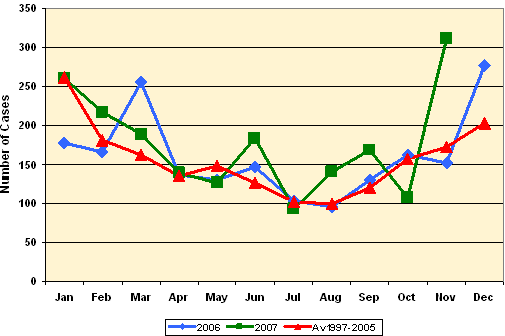
If last years figures are any guide then this dramatic rise is likely to be a one-off blip in the statistics rather than the start of a long-term trend.
The rise in missed heats and cystic ovaries was not followed by the number of anoestrus reports. Rather than the expected 50% rise in cases predicted by the long term average the rise was less than 20%, again highlighting the fact that although these three fertility problems are often grouped together and thought to have the same cause (or causes) this link is not absolute, with each of the problems having distinct risk factors not shared by the others.
The NADIS figures show this clearly for cystic ovaries and missed heats. These tend to share the same clinical signs before presentation to the vet, so there will be little bias due to selection of cases. Over the whole year there is one report of ovarian cysts for every seven non-detected oestruses. However this hides a small but significant monthly effect, with a higher proportion of cystic cows being seen September and December (see Figure 2a).
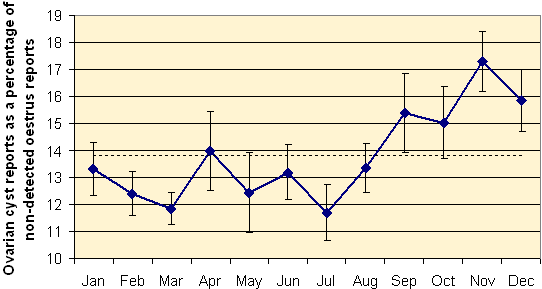
Clearly there are risk factors for ovarian cysts in late autumn / early winter which do not proportionately increase the risk of missed heats in cattle with apparently normal ovaries. The same is true year-on-year, but the pattern is less clear than that for the monthly variation (see Figure 2b), with no obvious trend up or down.
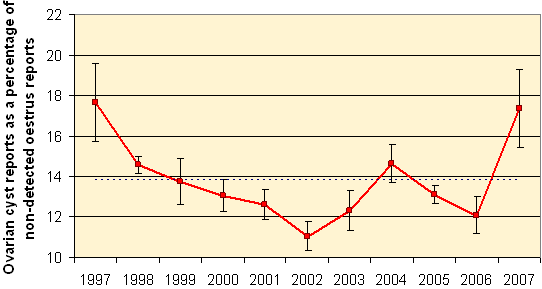
Classically ovarian cysts have been divided into follicular cysts and luteal cysts with the former being associated with increased oestrus activity. However the advent of cheap effective ultrasound has been associated with an increase in the proportion of diagnosed follicular cysts where the main problem is an absence of oestrus behaviour rather than nymphomania. Some of this may be better diagnosis but, overall even though follicular cysts remain a common problem, nymphomania is less commonly reported
Metabolic disease
Last month we predicted that the very low figures for hypomagnesaemia in October suggested that even if the weather was suitable it was unlikely that there would be many cases in November, however this proved not to be the case as the number of outbreaks in November was much higher than that in October. This seems to be an increasing trend with 4 of the last six years showing such a rise. Hypomagnesaemia is almost always associated with cattle at grass so the increase in November is due to the weather allowing cows to be kept outdoors on a grass-based diet for longer. Is this, like bluetongue, another symptom of global warming? Nevertheless despite the rise in November, overall this autumn has seen fewer cases of hypomagnesaemia than all but one previous year, so despite global warming the disease is clearly preventable which suggests that a focus on farmer education could be beneficial.
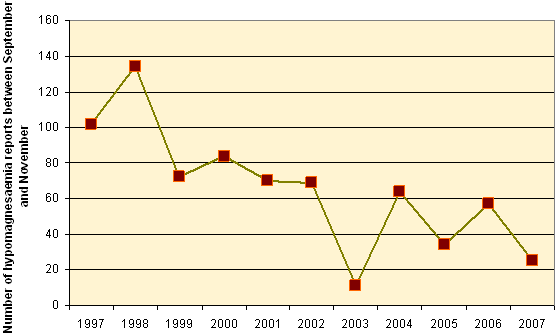
Lameness
Both foul-in-the-foot and digital dermatitis reports increased in November. Foul-in-the-foot reports this year have been at or above those of last year, whereas digital dermatitis reports have generally been below. The fact that foul-in-the-foot reports have remained stable whereas digital dermatitis have declined suggests that the reduction in NADIS reports of digital dermatitis outbreaks may not just be reduced veterinary involvement in disease but also a reduction in its importance as a cause of lameness. Certainly, the disease is changing on many farms from a cause of severe lameness to a chronic grumbling problem which only occasionally causes significant levels of lameness; a typical pattern for many new diseases. This combined with increased farmer familiarity with the disease are probably the two main factors driving the decline in NADIS reports. However neither of these explain the fall in foul-in-the-foot figures from 1997 to the current day (see Figure 4). Suggestions welcome!
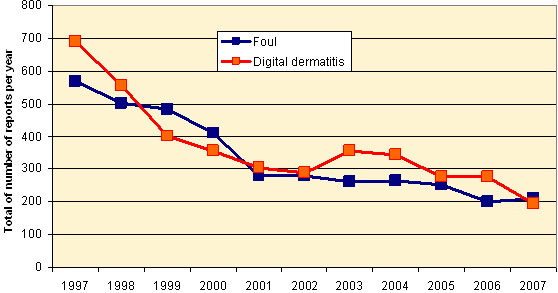
One significant area of concern is the downer cow. Reports of downer cows are now less than 25% of the 2005 figure. This is clearly a reflection of the value of down cows rather than a true reflection of the conditions frequency.
Other diseases
One vet reported a post-caesarean problem in a beef cow. A few days after the operation the cow had gut stasis and pyrexia, but no evidence of any abnormalities per vaginam or per rectum. A few days later there were palpable adhesions per rectum. Treatment was ineffective and the animal euthanased on humane grounds. This is the first time that this vet has recorded what seems to be an aseptic peritonitis with caesareans, although it did have a high temperature the ones that go wrong seem to go wrong from day one of the op not a few days later. He would be interested to hear if anyone else has come across this.
One potential problem identified in North Yorkshire was fluke in adult dairy cattle. The vet has been undertaking bulk milk samples for fluke on dairy farms and reports that the majority of farms seem to be carrying fluke in the milking cows. Because there is no product that can be used on milking cows without milk withhold a lot of them don’t get treated. We would be very interested to get further comments on fluke in dairy cattle.
A farmers meeting on Blue Tongue was recently hosted in Wiltshire. This was well attended but the participating vet was unable to find solid data on the bottom line costs of the disease to the cattle farm such as: if you get it how much does milk drop and what the morbidity and mortality rates are in cattle. We do need such data in farmer and vet-friendly form.
A North Yorkshire vet described an unusual respiratory problem on of his larger dairy farms. The disease is characterised by coughing and puffing in adult cows which he thinks may be due to pasteurellosis. The history of the farm is that in August, adult cattle had clinical lungworm which was treated with anthelminthics. Subsequently on housing they have had 1 cow a week showing the syndrome of coughing and puffing. Pleurisy appears to be the main clinical finding. BVD involvement has been suggested, a PCR on the bulk milk has identified no evidence of PIs in the milking herd. The condition remains sporadic and does respond to antibiotics. Investigation by the VLA is ongoing using money from their unusual diseases fund (an underappreciated and underfunded, but essential part of the VLA’s role in veterinary disease surveillance)
Another North Yorkshire vet detailed a very interesting cause of high cell counts in a 430 cow dairy herd which has a problem with high cell counts. The problem was traced to the towels used to clean the teats before milking. Each cow has it’s own individual towel, these are washed daily together in a washing machine. Bacterial tests have shown that the washing was not killing the bacteria so antiseptic has now been added to the wash cycle. Clearly the bacteria haven’t read the recent advice that 300 is sufficient!
CALVES
In November both calf scour and enzootic pneumonia remained at levels well below the long term average, although rises in pneumonia cases meant that in November, for only the second time this year more cases were reported than in the same month last year. Since 1997 the proportion of veterinary reports that have involved calf disease has dropped dramatically (Figure 5). NADIS data based on veterinary reports cannot show whether this is reduced disease or just reduced veterinary involvement (or both). However, NADIS is not just figures on computer, it is relies on reports from vets in the field who see the day-to-day situation on farm. Discussion with NADIS vets has highlighted the fact there is increased farmer treatment of disease, with better farmer understanding of disease leading to more prompt (and thus more effective) treatment. However, in addition to this, there is almost certainly a reduction in disease levels on farm mainly due to three factors: weather, stocking rate and vaccination. In recent years the weather at the critical timepoints for calf disease has been drier and warmer leading to fewer cases. Secondly, there has been a significant change on many dairy farms in terms of calf rearing with many selling bull calves off as soon as possible. Reduced stocking rates means reduced calf disease. The final change has been increased use of vaccination (for both scour and pneumonia). This combined with the improved efficacy of vaccination as newer vaccines have come on the market has undoubtedly improved calf welfare. Currently much of the research effort in the veterinary pharmaceutical industry is focussed on vaccination, hopefully this, combined with improved management, will lead to further improvements in disease control.
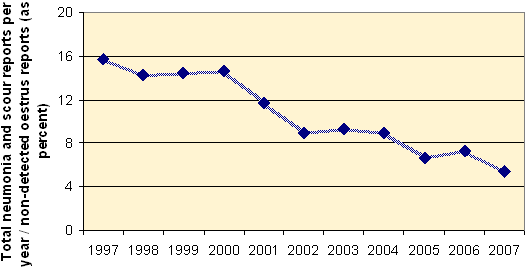
December 2007
Copyright © NADIS 2007


